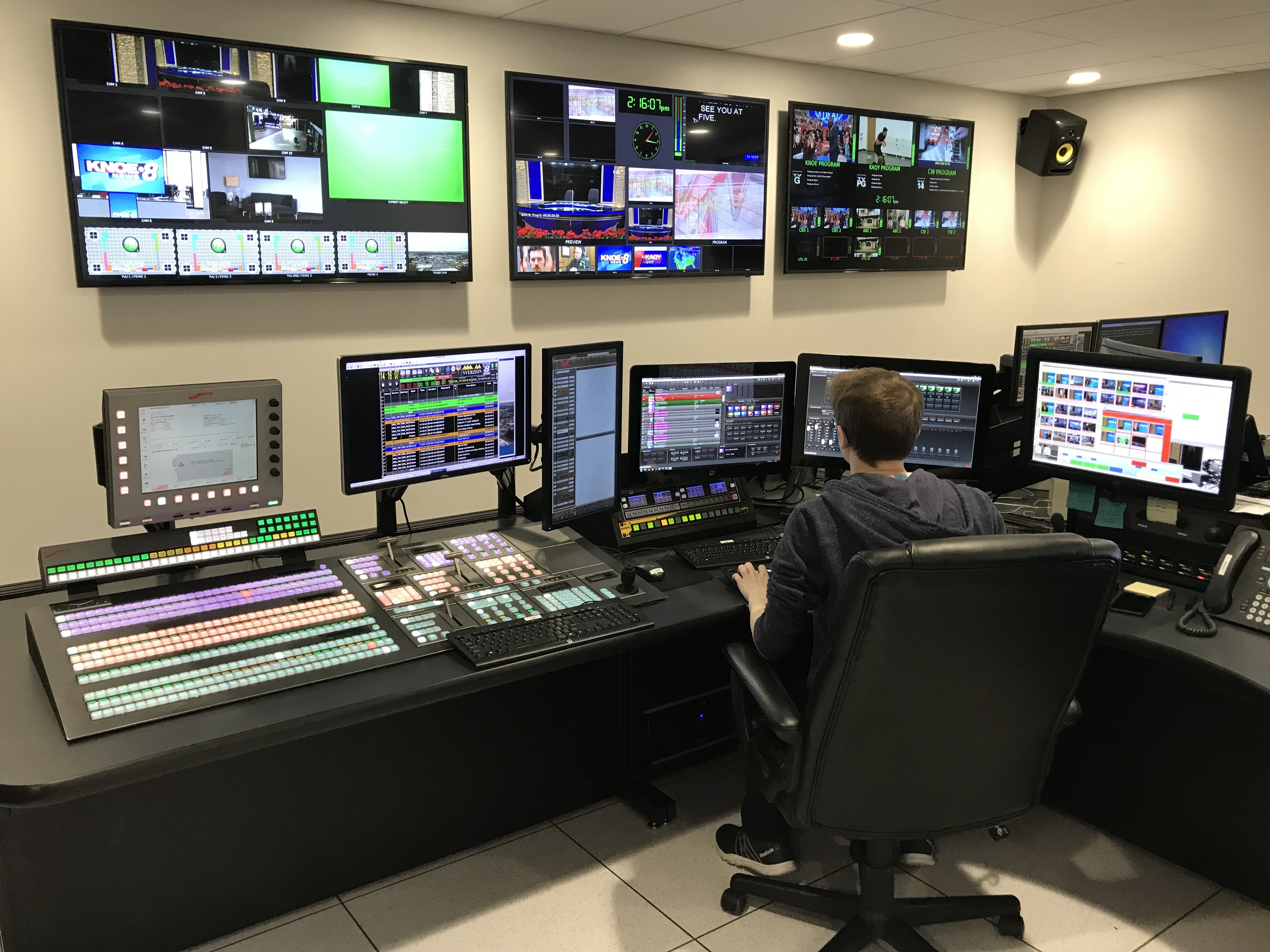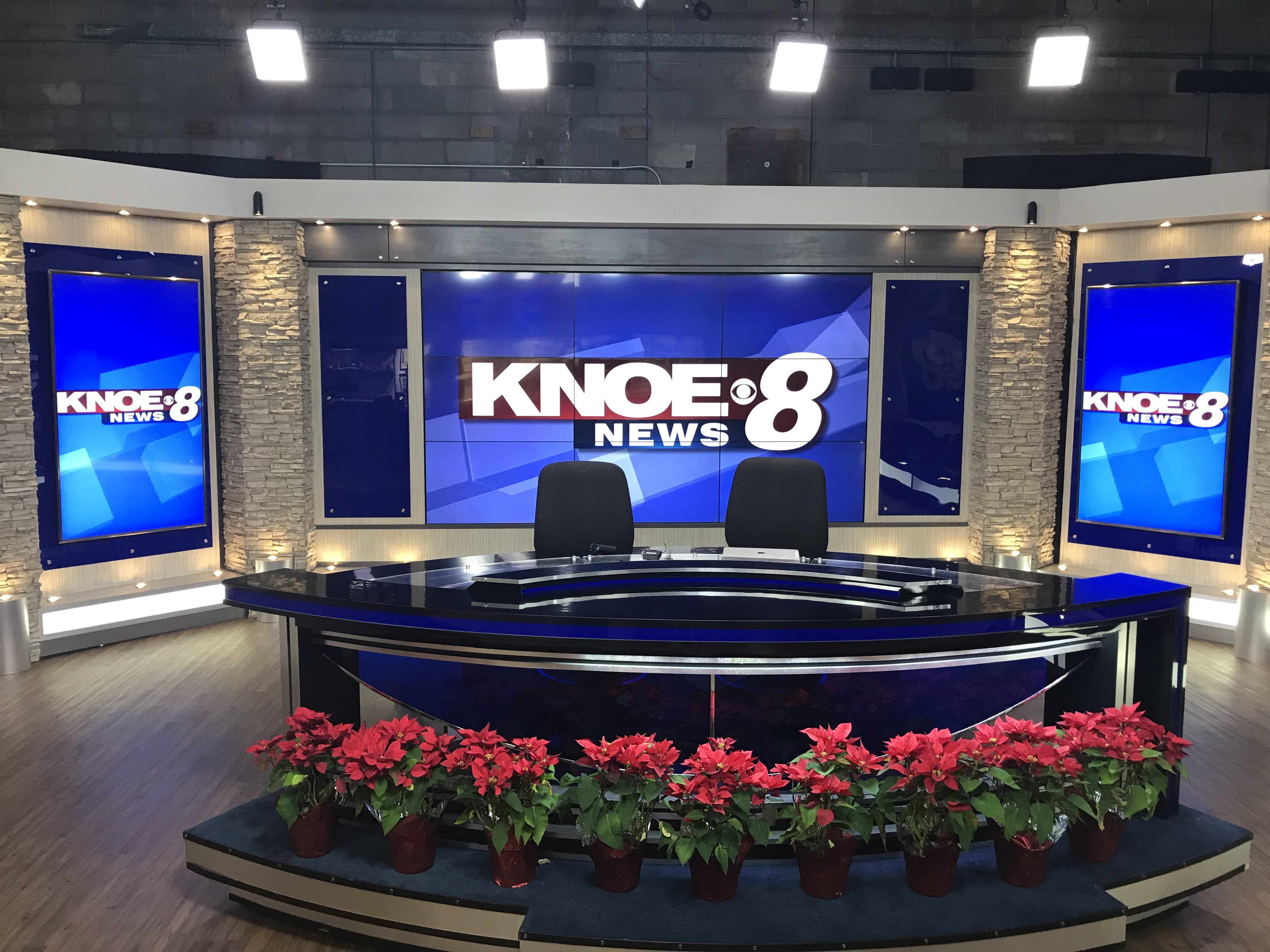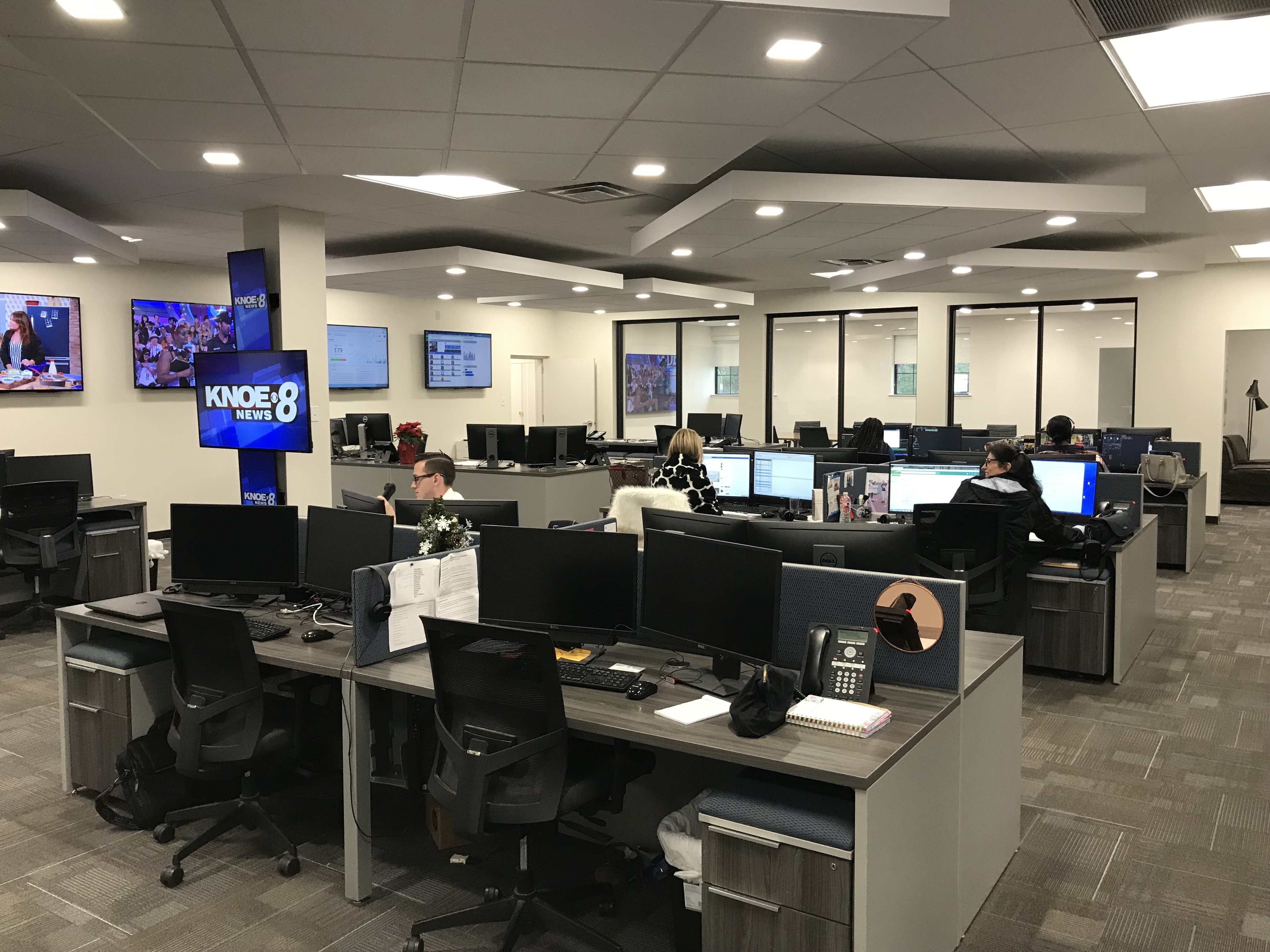MONROE, LA.—KNOE-TV, Gray Television’s CBS affiliate serving the ArkLaMiss area, last week celebrated completion of a major building renovation and technology upgrade that implements the station group’s vision for a modern, unified master control and production control room.
With a price tag of $4 million, the project not only outfitted the station for the future with new technology in the newsroom, control center and studio, but it also preserved the station’s exterior—a local fixture for the past 65 years since being founded by former Louisiana Governor James A. Noe Sr.
“While the exterior of our Oliver Road studios displays a vintage salute to our past, inside you will find a modern broadcast facility, fully equipped with the latest technology,” said KNOE General Manager Laura Long.
TECHNICAL MEDIA PRODUCTION
Like most television stations, KNOE operated with separate master control and production control rooms.
However, the renovation presented the station with the opportunity to implement Gray Television’s operational approach in which both functions are combined and run by a Technical Media Producer (TMP) from one room.

“That was the biggest transition for us–and of course, we went automated,” said Russell Kendrick, the station’s chief engineer.
At the heart of the TMP room is a 3.5M/E Ross Video Vision production switcher with Ross OverDrive news automation calling switcher functions, including control over Ross Cambotics robotic camera systems in the station’s new studio, he explained.
The professional video industry's #1 source for news, trends and product and tech information. Sign up below.
To handle increased demand for graphics for the station’s new 70-foot long primary news set, KNOE swapped out its existing two-channel Ross Xpression CG and graphics engine for a four-channel Xpression, said Kendrick.
Five Grass Valley multiviewers are located in the TMP room for monitoring, and a Grass Valley Kaleido-MX drives monitor arrays on the news set.
Two Logitek JetStream audio engines handle audio duties in the TMP room. A Logitek JetStream Plus is assigned as the primary audio mixer handling most tasks, including all mix-minuses, and a JetStream Mini with a conventional control surface is available as a backup.
A Ross Video Carbonite video switcher is also installed in the TMP room as a backup. “We have a lot of redundancy in the control room,” said Kendrick.
The station chose not to adopt IP routing and continues to direct baseband signals around its new facility using an existing 64 x 64 Utah Scientific routing switcher, he added.
STUDIO AND NEWS SET
KNOE produces local news for its CBS affiliate on its main channel and for its ABC affiliate on a digital subchannel out of the same new 50x100-foot studio.
Florida Set Works in Pensacola designed and built KNOE’s new news set, a hard set featuring a 4:3 aspect ratio monitor array consisting of nine monitors directly behind the news desk and a second array two monitors high and eight long to the right of the desk.

The local CBS newscast is produced from the desk, and the ABC newscast is done in front of the long monitor array. “When we do that news product, we can change out the graphics to suit the ABC newscast,” said Kendrick.
Five Sony PMW-320K XDCAM cameras are mounted to the Cambotics robotic camera heads, which are suspended above the set on the lighting grid. Another camera is mounted high on a wall in the studio to capture an overview for the closing shot of the newscasts.
Two rarely used roll-around cameras can be deployed as needed for cooking shows and other local productions, added Kendrick.
“This treatment makes the studio really big and clean with no clutter,” he added.
IN THE NEWSROOM
KNOE’s newsroom saw a major technology upgrade and renovation as well. Now occupying 4,000 square feet, the newsroom includes a workspace for reporters, producers and managers, green room area, sports office and the new TMP control room.
Two Panasonic AW-HE130KP3 PTZ cameras, controlled from the TMP room, are mounted in the area—one in the newsroom for live shots and the other in the green room, said Kendrick.

“When we did our remodel, a wall was built for that and plumbed for all the drops from the camera—reference, control, video out,” he explained. A teleprompter, confidence monitor and an air monitor were added to both. “That way, when talent or even a guest is in front of one of those camera positions, they know what is going on,” added Kendrick.
KNOE continues to use ENPS for its newsroom computer; however, it has made changes to enable reporters to edit their own stories. The station has replaced its old Adobe Premiere-based editing suites with Grass Valley EDIUS editing software running on reporters’ computers.
The station relies on a variety of tools to select and produce stories for its website, social media and mobile viewers, according to News Director Brad Ginsberg.
Ginsberg and his editorial team track the station’s digital content via Google Analytics and Social News Desk on monitors in the newsroom. “It’s a crucial part of our editorial meetings,” he said.
“We always start with weather, then digital, then we go into stories because reporters and everyone need to know what is hot right now on the digital side,” said Ginsberg.
CONSTRUCTION & LOGISTICS
CT Darnell Construction of Atlanta, which served as the general contractor, and 11 subcontractors from Monroe, La., were used to complete the renovation. Crews began the project in August 2017, and by May 2018 all structural work was completed. In July, the station went on air from its new news set.
Working around the ongoing renovation proved tough, said Kendrick. “We had a lot of refugees from the dust and debris show up,” he said.
Originally, production control and master control were on the second floor of the building along with the engineering tech core of the station—all in “a relatively small space,” he said.
During the construction, the entire sales staff, programming personnel and traffic joined engineering on the second floor.
“The actual office parts of engineering were the only sections that could be locked up at night,” Kendrick said. “So, anybody with sensitive information on their computers had to cram themselves in the engineering area.
“Everything got misplaced. Nobody’s phone extension was in the right place. You think you are calling somebody, but you are calling somebody else,” he recalled with a chuckle.
Transitioning the news department was easier, said Ginsberg. The newsroom stayed put while work was completed in a different part of the building on the new newsroom. Once that phase of work was complete, the news department simply moved into its new space.
Transitioning the news set proved to be a bit trickier, said Kendrick. For the changeover, KNOE dusted off an old virtual set, put up some temporary lighting and did its newscasts from the virtual set for about 10 days.
Over one weekend, workers disassembled the old news set and put up the new one, he said. Another week was spent lighting the set and “putting all the bits and pieces together,” he added.
“Of course, we had all the other construction going on at the same time—like building a new control room,” said Kendrick. “It was really something to do that much at one time.”
Despite the disruptions, dust and debris, the long-term rewards make any pain experienced during the renovation easy to accept.
“It was worth it,” said Long. “No one knows for certain where technology will lead us in the next 65 years, but I’m certain KNOE and Gray will remain on the forefront of the latest innovations, with a deep respect for where we started and those who made it possible.”
Phil Kurz is a contributing editor to TV Tech. He has written about TV and video technology for more than 30 years and served as editor of three leading industry magazines. He earned a Bachelor of Journalism and a Master’s Degree in Journalism from the University of Missouri-Columbia School of Journalism.

